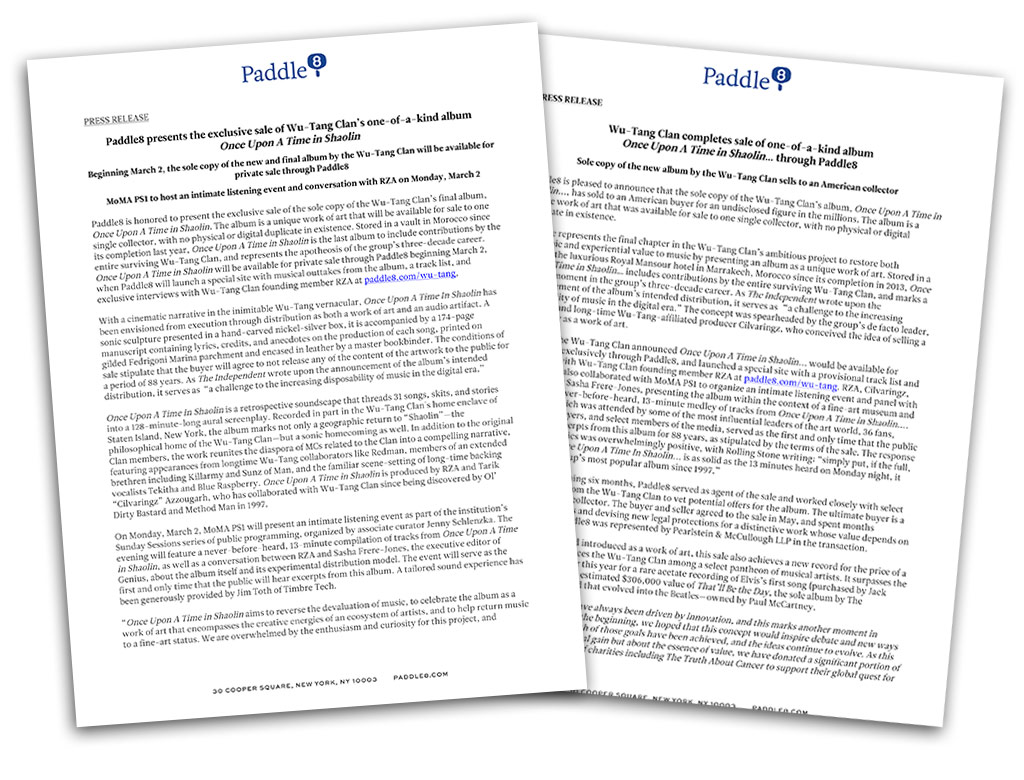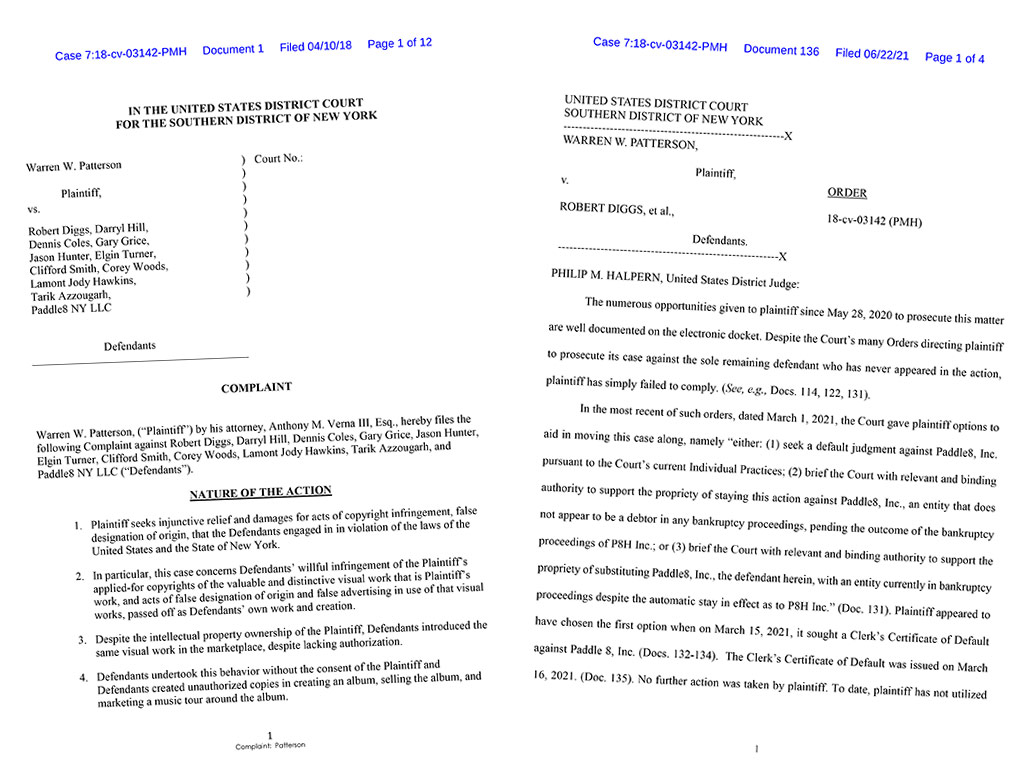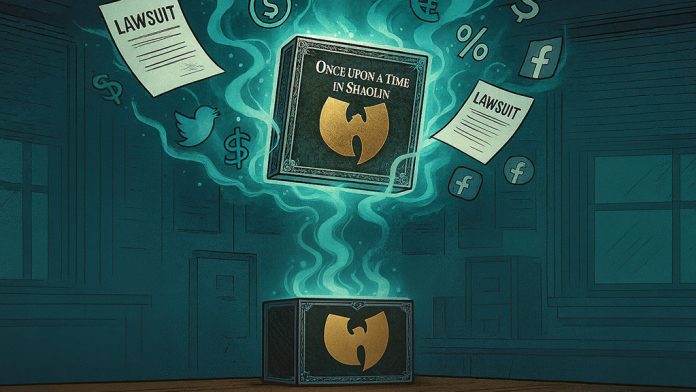Wu-Tang Clan’s Once Upon a Time in Shaolin isn’t just the world’s rarest album — it’s a magnet for lawsuits, scams, and legal chaos. Now, even journalists are getting dragged into the storm as Higbee & Associates launches a campaign of copyright threats on behalf of a photographer who already sued the Wu-Tang Clan, and lost…
One of the rarest pieces of recorded history may also be one of the music industry’s most cursed projects: Once Upon a Time in Shaolin, the seventh album by the Wu-Tang Clan.
Recorded over six years, the album blurs the line between music and fine art. It was pressed onto a single two-CD copy and housed in an ornate box created by British Moroccan artist Yahya. Producer Tarik “Cilvaringz” Azzougarh led the project with guidance from Wu-Tang Clan founding member RZA.

In 2015, the now-defunct auction house Paddle8 (archived) was enlisted to sell the work through an exclusive portal (archived). The company issued a press release and supporting images celebrating the sale of Once Upon a Time in Shaolin to an undisclosed buyer at a record-breaking price, with a similar statement issued via an affiliated art consortium known as Scluzay. The story became global news, covered by outlets of all sizes. Adding to the mystique, there was a stipulation that the album could not be released to the public until 2103.
The Dark Side of Shaolin
By December, the buyer was revealed: “pharma bro” Martin Shkreli of Turing Pharmaceuticals, a media fixture infamous for controversial drug pricing.
On February 9, 2016, New York-based artist Jason Koza sued RZA (Robert Diggs), Azzougarh, Shkreli, and Paddle8 for copyright infringement, alleging that his drawings were included in the album’s packaging. On May 4, Reuters reported that the case had been dropped, but the legal woes surrounding the album were just beginning.
Following Shkreli’s conviction for securities fraud, he surrendered Once Upon a Time in Shaolin to the U.S. government in March 2018.
Then, on April 10, 2018, UK-based photographer Warren W. Patterson sued Paddle8, Azzougarh, RZA, and other Wu-Tang members (first reported by The Blast), alleging copyright infringement over photos he took of Once Upon a Time in Shaolin between 2013 and 2014 (Patterson v. Diggs et al).

In the suit, Patterson sought $1 million in damages for the use of images — the same ones widely distributed to the media by Paddle8 beginning in 2015. Despite claiming that he had no contract and that he spent 80 hours photographing the album, Patterson filed a copyright registration for a group of related images in 2017 — nearly four years after the work was allegedly completed and two years after the album’s sale.
The filing also included emails between Patterson (using the name “Rashad” Patterson — the same credit listed on the Paddle8 images) and Azzougarh discussing the photos and press coverage. Some analysts argued that this correspondence itself indicated an “implied license” for the photos’ use.
After more than three years of legal debate (wasting the Court’s time), the case was dismissed and closed on June 22, 2021, just in time for a new chapter to unfold.
On July 27, 2021, the U.S. Department of Justice sold the album at auction to PleasrDAO. The sale — and another press release — fueled a fresh round of global coverage from Forbes, Newsweek, ABC, NBC, CBS, Vibe, Vice, XXL, Vanity Fair, TMZ, HuffPost, and even The Rock Father Magazine, among countless others.
A New Front in the Legal Battle: Target Journalists
As a journalist, you rarely — if ever — want to become part of the story. The old saying goes, “We don’t make the news, we just report it.” For this journalist, that changed on September 16, 2025, when I received a letter alleging copyright infringement for an image used in a news item published on July 27, 2021: the sale of Once Upon a Time in Shaolin.
In my more than 30-year media career, I’ve never been accused of infringement, nor have I been threatened by an attorney. However, I’ve seen my words and photographs plagiarized and lifted countless times. Those cases usually end with a cease-and-desist, a request for removal, or a DMCA takedown — and then I move on.
But this time was different.
Higbee & Associates, on behalf of Warren W. Patterson, demanded $2,000 for “unlawfully using” an image of Wu-Tang Clan’s Once Upon a Time in Shaolin — the very same photo distributed by Paddle8.
Receiving that demand revealed a fundamental misunderstanding of fair use protections and the implied license that comes with press-distributed images. Every newsroom on the planet follows this process daily: you report the news and support it with approved media assets provided for that purpose.
One of the strangest parts of this demand was timing. The story was more than three years old, and the image itself hadn’t been hosted on The Rock Father Magazine website in years. Through multiple redesigns and server migrations, hundreds — maybe thousands — of images from old news and reviews had vanished into the ether.
After some condescending back-and-forth emails, I enlisted legal counsel to review Higbee & Associates’ claims and the image’s origin. Following counsel’s advice, I responded — pointing back to Patterson’s prior litigation against Wu-Tang Clan and its associates.
The reply? More finger-pointing and accusations. During one exchange, Higbee’s “pre-litigation” attorney, Theodore “Ted” Sell, claimed he’d never heard of “Rashad” Patterson.
“Regarding Patterson v. Diggs et al., Mr. Patterson was representing himself so lacked [sic] the resources of his new firm – us,” Sell wrote in an email.
That is an outright lie.
In Patterson v. Diggs et al., Warren W. Patterson was represented by Anthony Verna III, Esq., of Verna Law, P.C.
And here’s where things get even weirder: Verna himself has publicly written about Higbee & Associates — including guides on how to respond to their demand letters and detailed thoughts on the firm’s tactics. Turns out, Higbee operates as a high-volume, automated business that issues thousands of copyright demand letters each year under the guise of “protecting artists’ rights.”
Upon closer investigation, Higbee & Associates has earned a reputation as a “copyright troll” or “serial plaintiff,” functioning more like a debt collection agency than a law firm. Their tactics would make even the mob blush: they send surprise invoices — demands for thousands of dollars accompanied by threats to sue for the maximum amount of damages, anywhere from $30,000 to $150,000.
In my case, they want $2,000 to make them go away.
My “crime”? Doing my job and reporting entertainment news.
After the bizarre exchange with Higbee, I reached out to the former head of communications at Paddle8 — the very auction house that originally distributed the Shaolin images.
“I can confirm that those photos were indeed distributed to press by Paddle8 and were cleared for press usage,” the rep said via email.
So did Patterson, years after suing and long after the company folded, decide to chase down every media outlet that used those images?
I emailed Patterson — who now operates under the name “Warren Wesley” — to ask directly if he was behind this.
As my Magic 8 Ball might say: “Signs point to yes.”
He quickly forwarded my message to Ted and the gang at Higbee & Associates, a firm that advertises itself like the ambulance-chasing roadside billboard lawyers of the IP world. “We don’t get paid until you get paid,” boasts one of their YouTube ads, a line that makes their harassment campaign even more suspect. The firm even runs a “settlement portal” for quick payments, like a collection agency with a law degree.
Could Once Upon a Time in Shaolin be back in headlines because of a more recent lawsuit from its current owner, PleasrDAO, against Martin Shkreli?
As reported by The National Law Review, that case, involving alleged “trade secrets,” is moving forward. That suit stems from a “leak” of music from the album, a sample of which has been live on YouTube for more than a year. And what a familiar photo used for the thumbnail:
Note: Patterson is also chasing YouTube users. In one case, a video featuring the album shared in 2018 was removed “due to a copyright claim by Warren Wesley Patterson.” The video, captured by the Wayback Machine, was still live as recently as August 29, 2024, indicating that its removal took place within the past year.
Meanwhile, I’m in a holding pattern, waiting for Patterson and Higbee & Associates to do the right thing and stop harassing me.
Patterson, notably, still celebrates the media attention from his Wu-Tang work. On his website, he displays screenshots from major outlets showing the very same Shaolin image — sometimes credited as “Paddle8” or “Rashad Patterson/Paddle8.”
These include a CNN feature on “Great Album Covers” (where Shaolin lands at No. 28, though the live version is suspiciously devoid of the image), a DJ Mag story titled “From Chambers to Chapters” with images credited to Flatiron Books/Paddle8, and even a clip from The Joe Rogan Experience, where Rogan and RZA pull up the same image via Google search. Watch the clip below, via YouTube.
While The Rock Father Magazine might not be a household name like Vanity Fair or Joe Rogan, reporting is reporting, and journalists deserve protection when they’re doing their jobs.
A Fight for Fair Use
There’s no way to know how many outlets that covered Once Upon a Time in Shaolin have received threatening letters or payment demands, but it’s clear some have removed images under pressure.
At press time, the image still appears in thousands of places across social media — often without credit or source. It’s even come to be known as the “album cover,” though that label is likely inaccurate.
Maybe it’s just another sign of the chaos that defines 2025, but Higbee & Associates seems to be targeting journalists with increasing frequency. While many of its lawsuits hit small businesses — salons, for example — two similar stories surfaced this month:
• Texas-based Boss Global Radio was targeted over a Selena Gomez image used in reporting and hit with a $5,000 demand.
• San Diego-based LaPrensa, a bilingual outlet founded in 1976, was hit with a $3,750 demand over a local news story image.
A common thread: Boss Global Radio, LaPrensa, and yours truly have all been contacted by Ted Sell, the Higbee attorney known for sending emails like this:
“This cannot be fair use as reuse of an image to illustrate that which is in the image is not transformative. Besides, again, reuse of news for news is the exact opposite of fair use and the image was initially used in news.”
That’s nonsense — and the law backs it up. Courts have consistently upheld image use by journalists under the fair use doctrine, 17 U.S.C. § 107.
The U.S. Copyright Office and Indiana University Bloomington both provide clear guidance on fair use, including specific principles for journalists and a section on fair use and photographs.
According to the Copyright Office, courts weigh four key factors:
- Purpose and character of the use: Noncommercial and transformative uses — those adding new meaning or context — favor fair use.
- Nature of the copyrighted work: Factual works (like news content) favor fair use more than creative ones.
- Amount and substantiality: Using small, non-central parts of a work favors fair use.
- Effect on the market: If the use doesn’t harm the original’s market, it’s more likely to be fair.
One notable precedent: Calkins v. Playboy Enterprises Int’l, Inc. (2004). In that case, a photographer sued Playboy for reusing a 1996 photo in a 2004 profile of Playmate Colleen Shannon. The court ruled in favor of Playboy, finding that the image was used to inform, not sell. Indiana University also notes that Calkins didn’t register her copyright until she prepared to sue — echoing Patterson’s timeline: photos taken in 2013, registration in 2017, and a lawsuit soon after.
For journalists and editors seeking clarity, the Center for Media & Social Impact’s Set of Principles for Fair Use in Journalism is essential reading.
The Curse Continues
Once Upon a Time in Shaolin may be the most expensive album ever made, and possibly the most cursed. What began as a bold artistic experiment has become a perpetual legal circus that enriches attorneys more than artists. And now, that curse has collateral damage.
Because in this twisted saga of art, money, and myth, Once Upon a Time in Shaolin still finds a way to haunt the press, one threatening letter at a time.
It’s been said that “Wu-Tang Clan Ain’t Nuthing ta F’ Wit,” and the same goes for The Rock Father.
Note: Nothing in this article is legal advice. If you are the target of a copyright troll, seek the advice of legal counsel.



